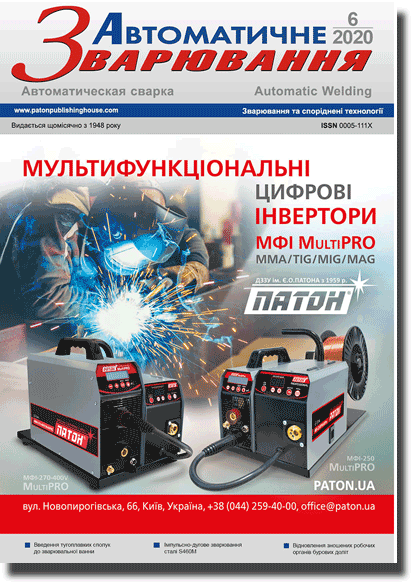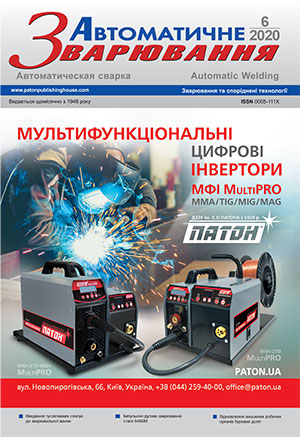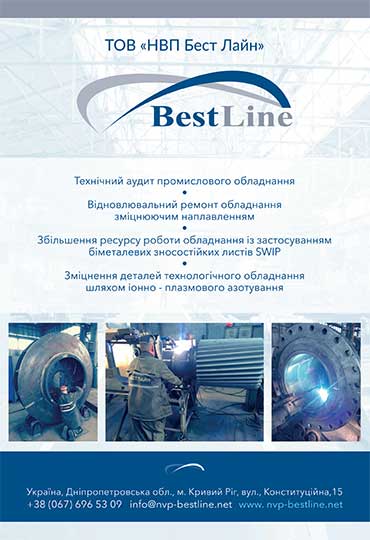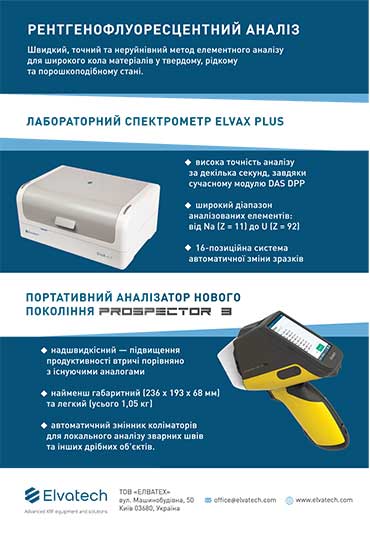| 2020 №06 (03) |
DOI of Article 10.37434/as2020.06.04 |
2020 №06 (05) |
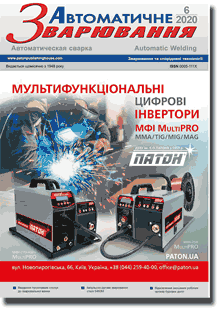
"Avtomatychne Zvaryuvannya" (Automatic Welding), #6, 2020, pp. 23-30
Influence of low-temperature tempered structure and properties of welded joints of high-strength steel 30Kh2N2MF
O.A. Gaivoronsky, V.D. Poznyakov, O.M. Berdnikova, T.O. Alekseenko, O.S. Shyshkevych
E.O. Paton Electric Welding Institute of the NAS of Ukraine, 11 Kazymyr Malevych Str., 03150, Kyiv, Ukraine. E-mail: office@paton.kiev.ua
The results of investigations of infl uence of low-temperature tempering on structural changes, physical and mechanical properties of HAZ metal and crack resistance of welded joints of a high-strength medium-carbon alloy steel 30Kh2N2MF are given. It is shown that the use of a low-temperature tempering is absolutely necessary during welding of products with low-alloy materials, which signifi cantly increases the crack resistance of welded joints. During welding of joints with high-alloy materials in the hardened metal, in the tempered HAZ metal a relatively more ductile and less stressed structure is formed, in which the maximum level of stresses is lower than that which can be achieved after thermal tempering of welded joint with a low-alloy weld. Therefore, the level of crack resistance of welded joints is suffi ciently high in any case and there is no need to use lowtemperature tempering for it. This is an unnecessary technological operation that does not signifi cantly aff ect the reliability during operation of products, but only increases their cost. 13 Ref., 4 Tabl., 6 Fig.
Keywords: high-strength steel, welded joints, low-temperature tempering, structure, properties, crack resistance
Received: 12.05.2020
References
1. Bernshtejn, M.L. (1968) Thermomechanical treatment of metals and alloys. In: 2 Vol. Moscow, Metallurgiya [in Russian].2. Lakhtin, Yu.M. (1983) Metal science and heat treatment of metals. Moscow, Metallurgiya [in Russian].
3. Fillipov, G.A., Sarrak, V.I. (1980) Local distribution of hydrogen and internal microstresses in structure of hardened steel. Fizika Metallov i Materialovedenie, 49, 121–125 [in Russian].
4. Grabin, V.F., Denisenko, A.V. (1978) Metal science of low- and medium-alloyed steels. Kiev, Naukova Dumka [in Russian].
5. Efimenko, M.G., Radzivilova, N.O. (2003) Metal science and heat treatment of welded joints. Kharkiv, NTU KhPI [in Ukrainian].
6. Anokhov, A.E., Korolkov, P.M. (2006) Welding and heat treatment in power engineering. Kyiv, Ekotekhnologiya [in Russian].
7. Makarov, E.L. (1981) Cold cracks in welding of alloyed steels. Moscow, Mashinostroenie [in Russian].
8. Gordonny, V.G., Gajvoronsky, A.A., Sargevsky, V.A., Lebedev, Yu.M. (1992) Influence of type of weld metal on structure, properties and resistance of joints of high-strength hardening steels to cold cracking. Avtomatich. Svarka, 11-12, 13–16 [in Russian].
9. Kozlov, R.A. (1969) Hydrogen in welding of hull plate. Leningrad, Sudostroenie [in Russian].
10. Poznyakov, V.A., Kostin, V.A., Gajvoronsky, A.A. et al. (2015) Effect of welding thermal cycle on structure-phase transformations and properties of HAZ metal of alloyed 30Kh2N2MF type medium-carbon steel. The Paton Welding J., 2, 7-13. https://doi.org/10.15407/tpwj2015.02.02
11. (1972) New methods for evaluation of brittle fracture resistance of metals. Ed. by Yu.N. Robotnov. Moscow, Mir [in Russian].
12. (1990) Strength of welded joints under alternating loads. Ed. by V.I. Trufyakov. Kiev, Naukova Dumka [in Russian].
13. Markashova, L.I., Grigorenko, G.M., Poznyakov, V.D. et al. (2009) Structural criterion for evaluation of strength, ductility, crack resistance of metals, alloys, composite materials and their welded joints. In: Proc. of 4th Int. Conf. on Fracture Mechanics of Materials and Strength of Structures, 447-451.
Advertising in this issue:
The cost of subscription/purchase order journals or individual articles
| Journal/Currency | Annual Set | 1 issue printed |
1 issue |
one article |
| TPWJ/USD | 384 $ | 32 $ | 26 $ | 13 $ |
| TPWJ/EUR | 348 € | 29 € | 24 € | 12 € |
| TPWJ/UAH | 7200 UAH | 600 UAH | 600 UAH | 280 UAH |
| AS/UAH | 1800 UAH | 300 UAH | 300 UAH | 150 UAH |
| AS/USD | 192 $ | 32 $ | 26 $ | 13 $ |
| AS/EUR | 180 € | 30 € | 25 € | 12 € |
| SEM/UAH | 1200 UAH | 300 UAH | 300 UAH | 150 UAH |
| SEM/USD | 128 $ | 32 $ | 26 $ | 13 $ |
| SEM/EUR | 120 € | 30 € | 25 € | 12 € |
| TDNK/UAH | 1200 UAH | 300 UAH | 300 UAH | 150 UAH |
| TDNK/USD | 128 $ | 32 $ | 26 $ | 13 $ |
| TDNK/EUR | 120 € | 30 € | 25 € | 15 € |
AS = «Automatic Welding» - 6 issues per year;
TPWJ = «PATON WELDING JOURNAL» - 12 issues per year;
SEM = «Electrometallurgy Today» - 4 issues per year;
TDNK = «Technical Diagnostics and Non-Destructive Testing» - 4 issues per year.





